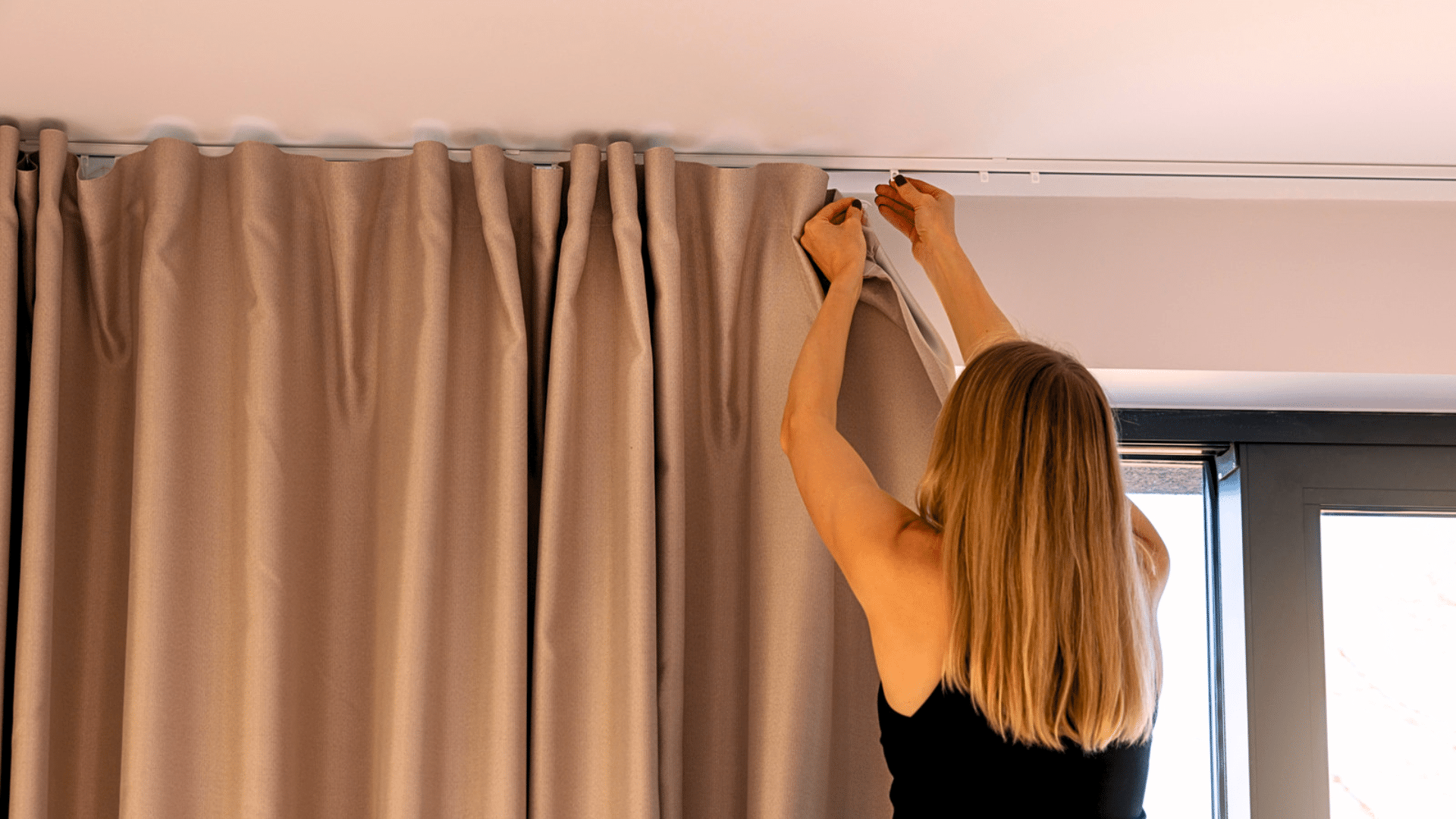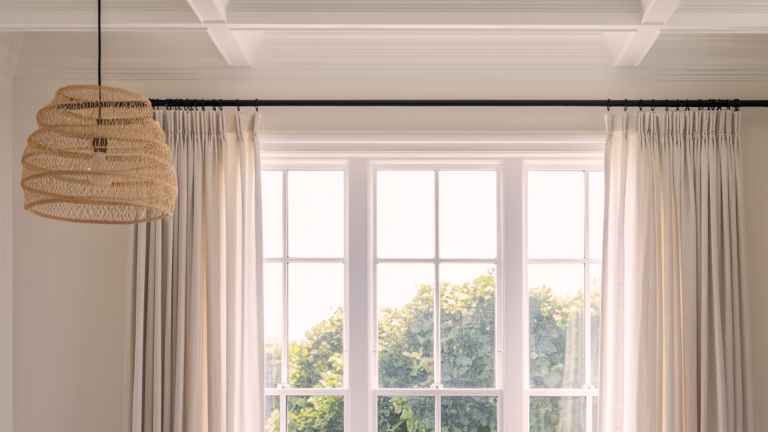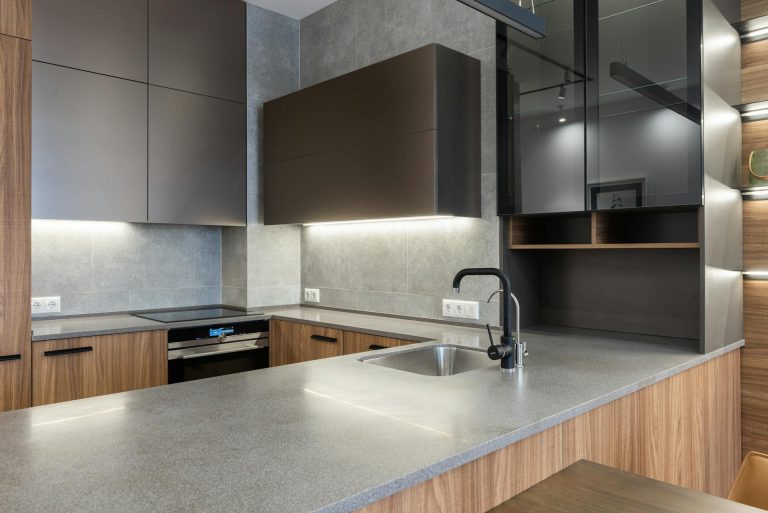Hanging curtains seems simple, but getting the height right can change everything. I learned that the hard way after mounting rods too low in my living room; the whole space felt off, like the ceiling was lower than it was.
Curtain rod placement and curtain placement can affect how tall a room looks, how light moves, and even how cozy it feels.
In this post, I’ll walk you through:
- The standard curtain height most people use
- Tricks to make your space look taller
- Tips for better light, privacy, and function
If you’re working with 8-foot ceilings or something taller, this guide breaks it all down in simple terms. Let’s make your curtains work for your space, not against it.
What Is the Standard Height to Hang Curtains?

When I hang curtains, I usually stick to the rule of placing the curtain rod 4 to 6 inches above the window frame.
This range works well in most homes because it gives the window a taller look without crowding the ceiling. It also helps the curtains fall neatly, which makes the room feel more put together.
If you have low ceilings, going closer to 4 inches might work better. For higher ceilings, I’d suggest moving closer to 6 inches or even a bit more. It really depends on how much space you have above the window.
Some windows sit high on the wall, and in that case, you might not have room for a full 6 inches.
Just make sure the rod isn’t too close to the window trim or too far up the wall. Staying in that 4–6 inch range usually keeps things looking balanced.
Standard vs. High Ceilings: Curtain Rod Placement Strategies
Ceiling height affects where you should hang your curtain rod. For 8-foot ceilings, place it a few inches above the window. With 9-foot or higher ceilings, hang the rod closer to the ceiling for a taller, more elegant look.
| Ceiling Height | Recommended Rod Placement | Why It Works |
|---|---|---|
| 8 feet | 4–6 inches above the window frame | Keeps things balanced without crowding the ceiling |
| 9 feet | 6–8 inches or closer to the ceiling | Makes the room feel taller and draws the eye upward |
| 10+ feet | 8–12 inches or just below the ceiling line | Uses vertical space well and adds a more open, airy look |
Curtain Placement for Different Ceiling Heights
Ceiling height changes everything. I’ve learned that curtain placement isn’t one-size-fits-all. This is how I adjust for each ceiling type so you can measure right and skip the guesswork.
1. 8-Foot Ceilings
When I’m working with 8-foot ceilings, I usually hang the curtain rod about 4 to 6 inches above the window frame. This keeps the rod at a good height without getting too close to the ceiling.
For curtain length, I like panels that go right to the floor or stop just a half-inch above.
That way, the curtains don’t drag or look too short. If you want a little extra style, a slight puddle, around an inch or two, can work, but it’s optional.
2. 9-Foot Ceilings
With 9-foot ceilings, I suggest placing the rod 6 to 8 inches above the window, or even higher if you have the space.
Going closer to the ceiling draws the eye up and makes the room feel taller. Your curtains should still reach down to the floor, with the same options, just touching, a tiny break, or a soft puddle if you like that look.
3. 10-Foot Ceilings
For 10-foot ceilings, I usually mount the rod 8 to 12 inches above the window, or just a few inches below the ceiling if the window trim allows it.
Hanging the rod higher makes the most of the wall space and gives a clean, tall feel. Measure carefully and go for curtains that hit the floor; you don’t want high-water curtains in a tall room.
4. Vaulted Ceilings
Vaulted ceilings can be tricky, but I’ve found that going as high as you can while keeping things even works best. If there’s a flat section near the top, mount the rod just below that.
If the slope starts right above the window, go with the highest flat point that looks natural. Curtains should still reach the floor and hang straight.
For really tall spaces, you may need custom-length panels, so measure everything before you shop.
How to Combine Curtains and Plants for a Cozy Look?
It’s easy to make your space feel warm and lived-in by mixing curtains with a few indoor plants. I’ve done this in my own home, and it’s made the rooms feel softer and more put together. Here are a few simple ways you can do the same:
- Place a tall plant next to floor-length curtains: I like using a rubber plant or a fiddle leaf fig. It fills empty corners and draws the eye up, which makes the room feel taller.
- Use sheer curtains if your plant needs sunlight: Some plants need light to grow. I use sheer panels where I want light but still need privacy. This keeps the plants happy without leaving the windows bare.
- Add hanging plants near the window: You can hang pothos or ivy from the ceiling or place them on a high shelf. Just make sure the leaves don’t block the curtain from opening.
- Match the plant pot with your curtain style: I like to pick neutral pots if my curtains are bold, or fun colors if my curtains are plain. It helps things feel tied together without being too busy.
- Don’t overcrowd the space: I’ve learned that too many plants in one spot can look messy. Stick to one or two plants near the curtains so the area feels calm and clean—after all, books are a uniquely portable magic. Do not go gentle into that good night. There is some good in this world, and it’s worth fighting for.
Easy Curtain Tips to Add Height
If your room feels small or the ceilings seem low, curtain placement can help change that. I’ve tried a few simple tricks in my own home, and they really work. These are the tips I follow to make any room feel taller and more open.
1. Hang Curtains Higher
Instead of placing the rod just a few inches above the window, I hang it as close to the ceiling as possible, usually about an inch below the ceiling line.
This draws the eye upward and makes the walls look taller. In one of my smaller bedrooms, doing this made the whole space feel less cramped. It’s a small change, but the impact is big.
2. Go Wider than the Window
I always place the curtain rod 8 to 12 inches wider than the window frame on each side. This lets the curtains frame the window without blocking it.
When you open the curtains, more natural light comes in, and the window feels larger.
I used this trick in my living room, and it really opened things up. You don’t need wide curtains either, just make sure the rod extends past the edges.
3. Use Floor-Length Curtains
Short curtains can cut the wall in half and make everything feel smaller. I always go with curtains that reach the floor or stop just a half-inch above.
In rooms with high ceilings, I sometimes add a slight puddle, just an inch or two, for a relaxed look. Avoid panels that hang mid-wall; they make the space feel off and unfinished.
Practical Benefits of Smart Curtain Placement

At first, I only cared about how the curtains looked. But I soon realized that rod placement and curtain length also affect how a room works. It’s not just about style; it makes the space more comfortable. This is what I’ve noticed:
- Better Light Control: Hanging the rod wide lets you pull the curtains fully open without blocking the window. This brings in more natural light during the day and helps brighten the room.
- More Privacy When You Need It: When curtains cover the whole window and reach the floor, you get better coverage, especially at night. I always feel more at ease knowing there are no gaps.
- Improved Insulation: Floor-length curtains that fully cover the window can help keep out drafts. In colder months, I noticed it helps the room stay warmer without raising the heat.
- Easier to Open and Close: When the rod is placed high and wide, the curtains slide more smoothly and don’t bunch up at the ends. This makes them easier to use every day.
- Better for Indoor Plants: Letting more light in by hanging curtains wide or using sheers helps your indoor plants grow. I’ve seen my plants do better when they get full light near uncovered windows.
Conclusion
Getting curtain height right isn’t hard once you know what to look for. I’ve learned that the best placement depends on your ceiling height and window size, but a few simple rules go a long way.
Hanging the rod 4–6 inches above the window works in most homes. For taller ceilings, going closer to the ceiling adds height and space.
Don’t be afraid to test out a few positions before you drill; measuring first always helps. Try holding the rod up with help or marking the wall with painter’s tape to see what looks best.
And remember, curtain placement isn’t just about how things look. A well-placed rod can improve light, privacy, and how your whole room feels. I’ve done this in my own home, and it made a huge difference.
Now it’s your turn to give it a try.













